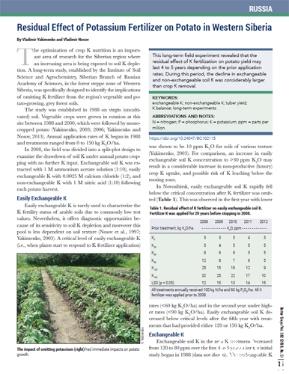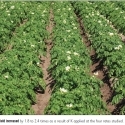15 Mar 2018
Residual Effect of Potassium Fertilizer on Potato in Western Siberia
Vladimir Yakimenko and Vladimir Nosov

The optimization of crop K nutrition is an important area of research for the Siberian region where an increasing area is being exposed to soil K depletion. A long-term study, established by the Institute of Soil Science and Agrochemistry, Siberian Branch of Russian Academy of Sciences, in the forest steppe zone of Western Siberia, was specifically designed to identify the implications of omitting K fertilizer from the region’s vegetable and potato-growing, grey forest soils.
The study was established in 1988 on virgin (uncultivated) soil. Vegetable crops were grown in rotation at this site between 1988 and 2000, which were followed by monocropped potato (Yakimenko, 2003; 2006; Yakimenko and Nosov, 2013). Annual application rates of K began in 1988 and treatments ranged from 0 to 150 kg K2O/ha.
In 2008, the field was divided into a split-plot design to examine the drawdown of soil K under annual potato cropping with no further K input. Exchangeable soil K was extracted with 1 М ammonium acetate solution (1:10), easily exchangeable K with 0.0025 М calcium chloride (1:2), and non-exchangeable K with 1 М nitric acid (1:10) following each potato harvest.
Easily Exchangeable K
Easily exchangeable K is rarely used to characterize the K fertility status of arable soils due to commonly low test values. Nevertheless, it offers diagnostic opportunities because of its sensitivity to soil K depletion and moreover this pool is less dependent on soil texture (Nosov et al., 1997; Yakimenko, 2003). A critical level of easily exchangeable K (i.e., when plants start to respond to K fertilizer application) was shown to be 10 ppm K2О for soils of various texture (Yakimenko, 2003). For comparison, an increase in easily exchangeable soil K concentration to >30 ppm K2О may result in a considerable increase in non-productive (luxury) crop K uptake, and possible risk of K leaching below the rooting zone.
In Novosibirsk, easily exchangeable soil K rapidly fell below the critical concentration after K fertilizer was omitted (Table 1). This was observed in the first year with lower rates (<60 kg K2О/ha) and in the second year under higher rates (<90 kg K2O/ha). Easily exchangeable soil K decreased below critical levels after the fifth year with treatments that had provided either 120 or 150 kg K2O/ha.
Exchangeable K
Exchangeable soil K in the zero K treatment decreased from 120 to 80 ppm over the first 4 to 5 years after the initial study began in 1988 (data not shown). The exchangeable K pool for this control remained at this minimum plateau concentration throughout the remainder of the study—including the period between 2008 and 2012 (Table 2). These minimum concentrations of exchangeable K depend on soil cation exchange capacity (CEC), which buffers against nutrient removal through crop harvest. In Western Siberia, this minimum is between 0.8 to 0.9% of the CEC for loam soils and 1.0 to 1.2% for sandy loam soils (Yakimenko, 2003). The minimum amount of exchangeable K is seemingly associated with K adsorbed on intramiccelar surfaces of the soil exchange complex (Yakimenko, 2015). Evidently, these exchangeable K surfaces are resistant to K depletion resulting from continuous potato cropping.
It is important to note that this apparent stability in exchangeable K is often wrongly interpreted as a positive situation while monitoring soil K fertility status. However, since this stabilization of exchangeable K occurs at a minimum concentration, many crops, and especially K-demanding crops like potato and vegetables, can suffer from K deficiency under this scenario.
Exchangeable soil K also declined in treatments that had received K fertilizer (Table 2). It decreased to the minimum concentration, or approached the minimum, in the second year for treatments that had previously received lower K rates (K30 and K60). Treatments previously receiving 90 kg K2O/ha saw a continual decline in exchangeable K concentrations in the years following K omission. Exchangeable K fell most noticeably in treatments that had the highest initial K concentrations (previously receiving 120 or 150 kg K2О/ha). Exchangeable K concentrations declined rapidly in these treatments over the five years of cropping, with the greatest decrease occuring within the first two years after stopping K fertilization.
Non-exchangeable K
Non-exchangeable K is an estimate of the soil K reserve that can replenish the exchangeable soil K pool. Non-exchangeable K is commonly considered as K+ ions situated within the interlayer positions of 2:1 type clay minerals. Non-exchangeable K concentrations stabilized in the zero K control in spite of the continual K removal through crop harvest (Table 3). Therefore, non-exchangeable K also appeared to reach a steady-state concentration near 900 ppm.
Omission of K fertilizer resulted in a decrease in non-exchangeable soil K. This decrease was most noticeable in treatments with higher K rates, which fell by between 300 and 600 ppm K2O compared to concentrations measured in 2007 (data not shown).
The relatively stable measurements of non-exchangeable K during an extended period of negative K balance suggests that an even more slowly available K is helping to maintain the existing equilibrium between soil K pools. This slowly available K pool seems to be non-extractable with the acid solutions used in this study and may be originating from primary soil minerals such as micas and feldspars. Micaceous structures have been shown to be the basic minerals in ‘physical clay’ (soil particles <0.01 mm) mainly affecting the K fertility status of this soil (Yakimenko, 2003).
Potato Tuber Yield
Tuber yield was strongly dependent on the fluctuations in weather during the growing season (Figure 1). The summer seasons of 2008, 2010, and especially 2012 were dry, but 2009 and 2011 seasons were favorable in both temperature and water availability.
Potato productivity also followed the changes in soil K status noted above. Yields in treatments with more residual fertilizer K were considerably higher compared to yields from the continuous zero-K control. However, tuber yields equalized across treatments by 2012. The relative yield produced under the residual effect of K fertilizer in the last experimental year was only 60 to 65% of the yield obtained under continuous application of K fertilizer (data not shown, Yakimenko, 2015). Therefore, it appears that the residual effect of K application could no longer support high yields by the fifth year of cropping.
Some residual benefit of K fertilizer might be continued further in treatments that received the highest K rates, but may only be expected in a favorable growing season. The final soil K concentration was not sufficient for potato nutrition in a dry year, which was the case in 2011, the last experimental year of this study.
Potassium Balances
A K balance was calculated based on fertilizer K input and K removal in the tubers and vines of potato that were also removed (Table 4). Potassium uptake by potato inincluding vines ranged from 27 kg K2О/ha/yr in the zero-K control to 95 kg K2O/ha/yr for the highest residual K treatment. Potassium removal was directly related to soil K fertility build up over the previous years of K fertilization. Plots with the highest K inputs had the most negative K balances.
The major changes in soil K forms measured during this experiment have occurred in the 0 to 20cm soil layer regardless of the K balance (Yakimenko, 2007). The extent of actual soil K depletion seems to considerably exceed the absolute values (ppm) of the negative K balances estimated in treatments that received K fertilizer in the past. Potassium removal with crop harvest alone does not explain the significant decrease in soil K forms observed over the years presented. Soil fixation of previously applied K may explain such findings. This fixed K is apparently not extracted with the acid solutions used in this study.
Summary
This study on the residual effects of accumulated soil K due to long-term application of K fertilizer indicates that the duration of residual K value for crop production depends on the K accumulation during the previous years. However, for these grey forest soils, any high quantities of K formed in the pools of varying plant availability over 20 years of K fertilization quickly revert (over 4 to 5 years) to the lower K concentrations inherent to uncultivated soils.
Dr. Yakimenko is Head, Laboratory of Agrochemistry, Institute of Soil Science and Agrochemistry, Siberian Branch of Russian Academy of Sciences, Novosibirsk; e-mail: yakimen-ko@issa.nsc.ru. Dr. Nosov is Director, IPNI Southern and Eastern Russia Region, Krasnodar; e-mail: vnosov@ipni.net.
References
Nosov, V.V. et al. 1997. Agrochemistry 5:13-19. (In Russian).
Yakimenko, V.N. 2015. Agrochemistry 4:3-12. (In Russian).
Yakimenko, V.N. 2007. Agrochemistry 3:5-11. (In Russian).
Yakimenko, V.N. 2006. Agrochemistry 5:3-9. (In Russian).
Yakimenko, V.N. 2003. Potassium in Western Siberia Agrocoenoses. Siberian Branch of Russian Academy of Sciences Printing House, Novosibirsk, Russia. 231 p. (In Russian).
Yakimenko, V.N. and V.V. Nosov. 2013. Better Crops 97(2):22-24.




